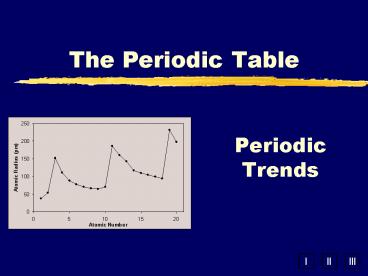Periodic Trends - PowerPoint PPT Presentation
1 / 23
Title:
Periodic Trends
Description:
The Periodic Table Periodic Trends Periodic Properties Atomic Radius the distance between two identical atoms bonded together Periodic Properties Electronegativity ... – PowerPoint PPT presentation
Number of Views:206
Avg rating:3.0/5.0
Title: Periodic Trends
1
Periodic Trends
- The Periodic Table
2
Periodic Properties
- Atomic Radius
- ½ the distance between
- two identical atoms
- bonded together
- Ionization Energy
- Energy required to
- remove one e- from a
- neutral atom.
3
Periodic Properties
- Electron Affinity
- Attraction for additional electrons
- Electronegativity
- Pull an atom has on electrons when bonded to
another atom
4
A. Atomic Radius
- Atomic Radius
- Increases to the LEFT and DOWN
5
A. Atomic Radius
- Why larger going down?
- Adding energy levels
- Shielding - core e- block the attraction between
the nucleus and the valence e-
6
A. Atomic Radius
- Why smaller to the right?
- Increased nuclear charge (i.e. more protons in
nucleus) without more shielding pulls e- in
tighter
7
A. Atomic Radius
Nucleus not strong enough to pull valence e- in
tight
Stronger nucleus pulls valence e- in tight
8
A. Atomic Radius
- Atomic Radius
K
Na
Li
Ar
Ne
9
B. Ionic Radius
- Ionic Radius
- Cations ()
- lose e-
- smaller
- Anions ()
- gain e-
- larger
10
B. Ionic Radius
- Ionic Radius
- Tug of War between positive nucleus and
negative electrons.
- Cations nucleus is stronger
- Anions electrons are stronger
11
Examples
- Which atom has the larger radius?
- Be or Ba
- Ca or Br
Ba Ca
12
Examples
- Which particle has the larger radius?
- S or S2-
- Al or Al3
S2- Al
13
C. Ionization Energy
- First Ionization Energy energy needed to remove
ONE electron.
He
Ne
Ar
Na
Li
K
14
C. Ionization Energy
- First Ionization Energy
- Increases UP and to the RIGHT
15
C. Ionization Energy
- Why opposite of atomic radius?
- In small atoms, e- are close to the nucleus where
the attraction is stronger it takes a lot of
energy to strip an e- away! - Why small jumps within each group?
- Stable e- configurations dont want to lose e-
16
C. Ionization Energy
- Successive Ionization Energies
- Large jump in I.E. occurs when a CORE e- is
removed after all valence e- have been removed.
- Mg 1st I.E. 736 kJ
- 2nd I.E. 1,445 kJ
- Core e- 3rd I.E. 7,730 kJ
17
C. Ionization Energy
- Successive Ionization Energies
- Large jump in I.E. occurs when a CORE e- is
removed after all valence e- have been removed.
- Al 1st I.E. 577 kJ
- 2nd I.E. 1,815 kJ
- 3rd I.E. 2,740 kJ
- Core e- 4th I.E. 11,600 kJ
18
Examples
- Which atom has the higher 1st I.E.?
- N or Bi
- Ba or Ne
N Ne
19
D. Electron Affinity
- Electron Affinity
- Increases UP and to the RIGHT
20
D. Electron Affinity
- Why smaller going down?
- e- further from the nucleus
- Greater shielding additional e- feel the
attraction from the nucleus less. - Why greater to the right?
- Higher nuclear charge without greater shielding
stronger nucleus has a greater attraction for e-
(atoms tend to make anions)
21
Examples
- Which atom has the higher e- affinity?
- K or Br
- F or I
Br F
22
E. Electronegativity
- Electronegativity
- Increases UP and to the RIGHT
23
Examples
- If the following atoms were bonded together,
which would have the higher electronegativity?
- P or S
- Se or O
S O
24
F. Melting/Boiling Point
- Melting/Boiling Point
- Highest in the middle of a period.































